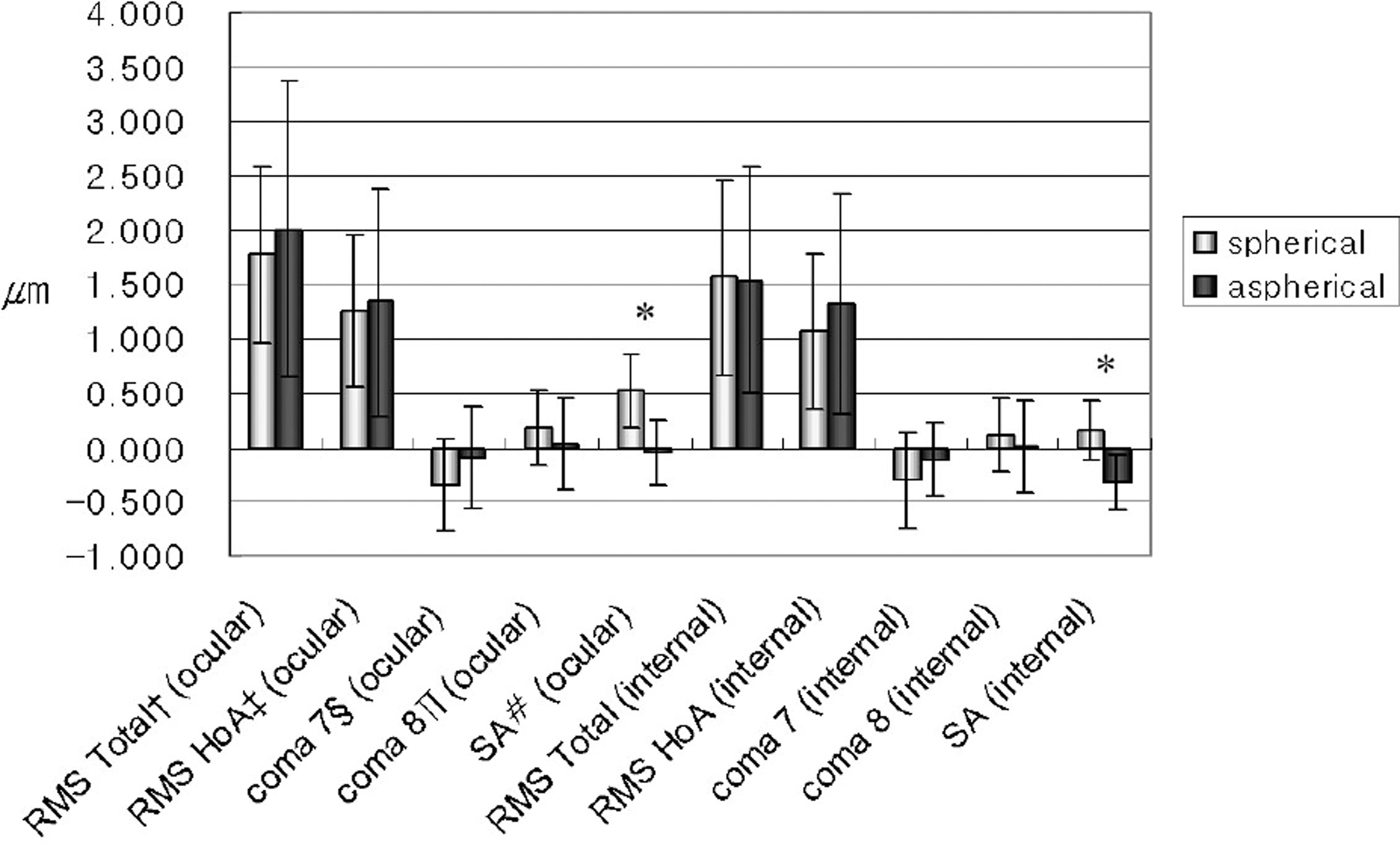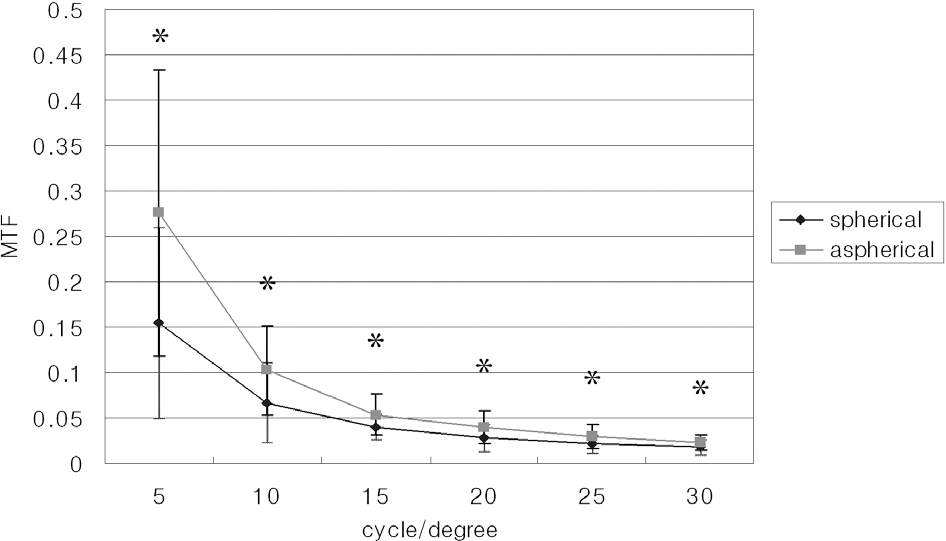J Korean Ophthalmol Soc.
2008 Aug;49(8):1248-1255. 10.3341/jkos.2008.49.8.1248.
Wavefront and Visual Function Analysis After Aspherical and Spherical Intraocular Lenses Implantation
- Affiliations
-
- 1Vision Research Institute, Department of Ophthalmology, Yonsei University College of Medicine, Seoul, Korea. tikim@yuhs.ac
- 2Department of Ophthalmology, Soonchunhyang University College of Medicine, Bucheon, Korea.
- KMID: 2211728
- DOI: http://doi.org/10.3341/jkos.2008.49.8.1248
Abstract
-
PURPOSE: To compare postoperative wavefront aberration and visual functions between aspherical Tecnis Z9003, a new acrylic aspheric intraocular lens (IOL), and spherical AcrySof SA60AT IOL.
METHODS
Fifty patients (56 eyes) who underwent cataract extraction and were implanted with spherical or aspherical IOLs were randomly evaluated by wavefront analysis, including an examination of spherical aberration and higher-order aberrations using two different types of aberrometers (ray tracing and automatic retinoscope), manifested refraction, a contrast sensitivity test, and modulation transfer function (MTF), three months after surgery. RESULT: There were no statistically significant differences of spherical equivalent and best-corrected visual acuity between the two different IOL groups. However, the aspherical IOL group showed less spherical aberration and better contrast sensitivity and MTF than the spherical IOL group.
CONCLUSIONS
Tecnis Z9003 could compensate for positive spherical aberrations of the cornea and improve contrast sensitivity and MTF, thereby improving visual function.
Keyword
Figure
Cited by 3 articles
-
Spherical Aberration, Contrast Sensitivity and Depth of Focus With Three Aspherical Intraocular Lenses
Hyoung Won Bae, Eung Kweon Kim, Tae-Im Kim
J Korean Ophthalmol Soc. 2009;50(11):1639-1644. doi: 10.3341/jkos.2009.50.11.1639.Comparison of Optical Performances in Eyes Implanted With Aspheric and Spherical Intraocular Lenses After Cataract Surgery
Jin Ho Jeong, Mee Kum Kim, Won Ryang Wee, Jin Hak Lee
J Korean Ophthalmol Soc. 2010;51(11):1445-1452. doi: 10.3341/jkos.2010.51.11.1445.Comparisons of Clinical Results after Implantation of Three Aspheric Intraocular Lenses
Kahyun Lee, Myung Hun Yoon, Kyoung Yul Seo, Eung Kweon Kim, Tae-im Kim
J Korean Ophthalmol Soc. 2013;54(8):1213-1218. doi: 10.3341/jkos.2013.54.8.1213.
Reference
-
References
1. Owsley C, Sekuler R, Siemsen D. Contrast sensitivity throughout adulthood. Vision Res. 1983; 23:689–99.
Article2. McLellan JS, Marcos S, Burns SA. Age-related changes in monochromatic wave aberrations of the human eye. Invest Ophthalmol Vis Sci. 2001; 42:1390–5.3. Guirao A, Redondo M, Artal P. Optical aberrations of the human cornea as a function of age. J Opt Soc Am A Opt Image Sci Vis. 2000; 17:1697–702.
Article4. Oshika T, Klyce SD, Applegate RA, Howland HC. Changes in corneal wavefront aberrations with aging. Invest Ophthalmol Vis Sci. 1999; 40:1351–55.5. Artal P, Berrio E, Guirao A, Piers P. Contribution of the cornea and internal surface to the change of ocular aberrations with age. J Opt Soc Am A Opt Image Sci Vis. 2002; 19:137–43.6. Artal P, Guirao A, Berrio E, Williams DR. Compensation of corneal aberrations by the internal optics in the human eye. J Vis. 2001; 1:1–8.
Article7. Mester U, Dillinger P, Anterist N. Impact of a modified optic design on visual function: clinical comparative study. J Cataract Refract Surg. 2003; 29:652–60.
Article8. Rawer R, Stork W, Spraul CW, Lingenfelder C.Imaging quality of intraocular lenses. J Cataract Refract Surg. 2005; 31:1618–31.
Article9. Guirao A, Redondo M, Geraghty E. . Corneal optical aberrations and retinal image quality in patients in whom monofocal intraocular lenses were implanted. Arch Ophthalmol. 2002; 120:1143–51.
Article10. Chalita MR, Krueger RR. Correlation of aberrations with visual acuity and symptoms. Ophthalmol Clin North Am. 2004; 17:135–42.
Article11. Holladay JT, Piers PA, Koranyi G. . A new intraocular lens design to reduce spherical aberration of pseudophakic eyes. J Refract Surg. 2002; 18:683–91.
Article12. Packer M, Fine IH, Hoffman RS, Piers PA. Prospective randomized trial of an anterior surface modified prolate intraocular lens. J Refract Surg. 2002; 18:692–6.
Article13. Bellucci R, Scialdone A, Buratto L. . Visual acuity and contrast sensitivity comparison between Tecnis and AcrySof SA60AT intraocular lenses: a multicenter randomized study. J Cataract Refract Surg. 2005; 31:712–7.
Article14. Denoyer A, Lez ML, Majzoub S, Pisella P. Quality of vision after cataract surgery after Tecnis Z9000 intraocular lens implantation: Effect of contrast sensitivity and wavefront aberration improvements on the quality of daily vision. J Cataract Refract Surg. 2007; 33:210–6.15. Rozema JJ, Van Dyck D, Tassignon M. Clinical comparison of 6 aberrometers. Part I: Technical specifications. J Cataract Refract Surg. 2005; 31:1114–27.16. Marcos S, Barbero S, Jimenez-Alfaro I. Optical quality and depth-of-field of eyes implanted with spherical and aspheric intraocular lenses. J Refract Surg. 2005; 21:223–35.
Article17. Padmanabhan P, Yoon G, Porter J. . Wavefront aberration in eyes with acrysof monofocal intraocular lenses. J Refract Surg. 2006; 22:237–42.18. Park I, Park C, Ryu K. Corneal Astigmatic Changes by Temporal Incision or Oblique Incision in Sutureless Cataract Surgery. J Korean Ophthalmol Soc. 1995; 36:1467–72.19. Guirao A, Tejedor J, Artal P. Corneal aberrations before and after small-incision cataract surgery. Invest Ophthalmol Vis Sci. 2004; 45:4312–9.
Article20. Barbero S, Marcos S, Jime´nez-Alfaro I. Optical aberrations of intraocular lenses measured in vivo and in vitro. J Opt Soc Am A Opt Image Sci Vis. 2003; 20:1841–51.
Article21. Atchison DA. Design of aspheric intraocular lenses. Ophthalmic Physiol Opt. 1991; 11:137–146.
Article22. Altmann GE, Nichamin LD, Lane SS, Pepose JS. Optical performance of 3 intraocular lens designs in the presence of decentration. J Cataract Refract Surg. 2005; 31:574–85.
Article23. Wang L, Koch DD. Effect of decentration of wavefront- corrected intraocular lenses on the higher-order aberrations of the eye. Arch Ophthalmol. 2005; 123:1226–30.24. Akkin C, Ozler SA, Mentes J. Tilt and decentration of bag fixated lenses: a comparative study between capsulorrhexis and envelope techniques. Doc Ophthalmol. 1994; 87:199–209.25. Mutlu FM, Bilge AH, Altinsoy HI, Yamusak E. The role of capsulotomy and intraocular lens type on tilt and decentration of polymethylmethacrylate and foldable acrylic lenses. Ophthalmologica. 1998; 212:359–63.
Article26. Hayashi K, Harada M, Hayashi H. . Decentration and tilt of polymethyl methacrylate, silicone, and acrylic soft intraocular lenses. Ophthalmology. 1997; 104:793–8.
Article27. Norrby NE, Grossman LW, Geraghty ED. . Determining the imaging quality of intraocular lens. J Cataract Refract Surg. 1998; 24:703–14.28. Ginsburg AP. Contrast sensitivity: determining the visual quality and function of cataract, intraocular lenses and refractive surgery. Curr Opin Ophthalmol. 2006; 17:19–26.
- Full Text Links
- Actions
-
Cited
- CITED
-
- Close
- Share
- Similar articles
-
- Comparison of the Clinical Effects of Implantation of Aspheric and Spherical Intraocular Lenses
- Spherical Aberration, Contrast Sensitivity and Depth of Focus With Three Aspherical Intraocular Lenses
- Clinical Efficacy of Bunny Multifocal Intraocular Lens after Cataract Surgery
- Comparison of Visual Function Between Two Aspheric Intraocular Lenses After Microcoaxial Cataract Surgery
- Comparison of Wavefront Analysis and Visual Function Between Monofocal and Multifocal Aspheric Intraocular Lenses








